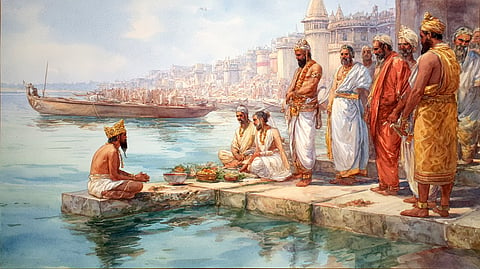- Commentary
- History Vignettes
- Notes on Culture
- Dispatches
- Podcasts
- Indian LanguagesIndian Languages
- Support

LIKE ALL SMRITIS, the Dēvala-Smriti too, relies on Pūrva-Sūris — Past Masters — from which it derives its own acceptance and authority. In the fourth volume of his History of Dharmasastra, P.V. Kane offers a brilliant exposition of this point. Among other things, he cites two representative verses from the Manu Smriti and the Vishnu Dharmasastra, which make the same point. Their summary is as follows:
Both the aforementioned verses composed more than two thousand years before the Dēvala-Smriti pithily capture the whole essence of the indescribable ordeals suffered by the Hindu society under the prolonged spell of Islamic rule in India. Thus, every injustice — savage wars, enslavement, forcible conversions, and bigoted taxes like Jaziya — meted out to Hindus had the sanction of Islamic scripture.
Philosophically, the aforementioned Dharmasastric dictum is also a stark commentary on all sorts of unjust legislations passed in “democratic” India sponsored by various lobbies that have the specific goal to break India by de-Hinduising its society.
Thus, relying on such timeless Dharmasastra precepts, Kane makes the following proclamation with regard to Ghar-Wapsi:
…the burning desire of many people forcibly converted in times of disturbances to return to the Hindu fold and to the religion of their forefathers, the movement called Shuddhi, should be encouraged by all interested in the well-being and stability of the Hindu society.
ANOTHER ANCIENT RITUAL that forms one of the bases for the Parāvartana or the Mlēccita-śud'dhi ceremony mentioned in the Dēvala-Smriti is the Vrātya-stōma. The origins of the Vrātya-stōma can be traced back to the Tāṇḍya Mahābrāhmaṇa (also known as Pan̄cavimśa). The interested reader is referred to Kane’s extensive discussion on the subject in the second volume of his History of Dharmasastra — pages 385-91.
Vrātya variously means “tramp,” “vagrant,” “foreigner,” “vile person,” “a person lacking Samskara,” “people not engaged in Svādhyāya,” and so on.
The Vrātya-stōma was the typical ceremony performed for admitting foreigners into the Sanatana society during the pre-Islamic period. This is how the Greeks, Śakas, Huns, et al., were formally admitted into the Hindu society. It was by no means an easy process; on the contrary, it was an extremely demanding process in which the aspirant’s purity and conduct were tested at every step over a long time. P.V. Kane describes this in a generic fashion:
…as Hinduism has been extremely tolerant…it had a wonderful power of quiet and unobtrusive absorption. If a person, though of foreign ancestry, conformed to Hindu social usages in outward behaviour, in course of time his descendants became absorbed into the vast Hindu community. This process has gone on for at least two thousand years.
To give a loose analogy, an alien becoming a Hindu was akin to a Hindu who today seeks the coveted American citizenship. Even the green card — granted or denied on whim even after the Hindu has lived and served the US for a decade or longer — is no guarantee of full citizenship.
The fact that the Vrātya question had continuously engaged the attention of all Dharmasastra authors for untold centuries can be seen for example, in Nagoji Bhatta’s compendium unambiguously titled Vrātyatā-śud'dhisaṅgraha published as recently as the 18th century — i.e., an entire millennium after the first Muslim invasion of Sindh.
The timeline is extremely significant.
By Nagoji Bhatta’s era, Bharatavarsha had become almost unrecognisable. The Hindu society was groaning under the extended oppression of Muslim rule; a substantial chunk of Hindus had become Muslims; yet, there was no dearth for savants like Nagoji Bhatta who, generation after generation, were alert to the existential question of safeguarding the Sanatana Samaja. Nagoji Bhatta, grandson of the illustrious Bhattoji Dikshita, lived in an era that witnessed Aurangzeb’s death and the total collapse of Mughal rule.
Contrast this with what a handful of self-seekers have done to the Hindu society and the Hindu Rashtra called India after 1947. India has the largest population of illegal immigrants in the world; most of them are Bangladeshi and now, Rohingya Muslims, feeding off the resources of the Hindus and devouring the Hindu society from within.
As long as there are born Mlecchas who voluntarily wish to embrace Sanatana Dharma even to this day, the Vrātya-stōma is a handy, reliable, readymade, and infallible guide. Over the centuries, several westerners including Schopenhauer, Emerson, Thoreau, Walt Whitman, Romain Rolland, Christopher Isherwood, Joseph Campbell, Aldous Huxley, T.S. Eliot, and J.D. Salinger had embraced Sanatana Dharma in their intellectual life and inward attitude although they didn’t ceremonially convert to Hindu Dharma.
In our own time, we have the shining examples of Koenraad Elst and David Frawley. Frawley’s remarkable spiritual journey narrated in his How I Became a Hindu, which culminated in him formally becoming a Hindu and adopting the name Vamadeva Sastri, is a must-read account for all born Hindus who are either ignorant of the grandeur and beauty of their own Dharma or are seduced by oily missionaries and dazzled by the resplendent facade of American materialism.
To be continued
The Dharma Dispatch is now available on Telegram! For original and insightful narratives on Indian Culture and History, subscribe to us on Telegram.
